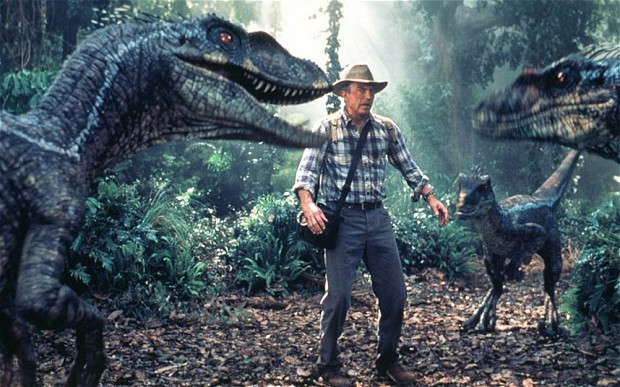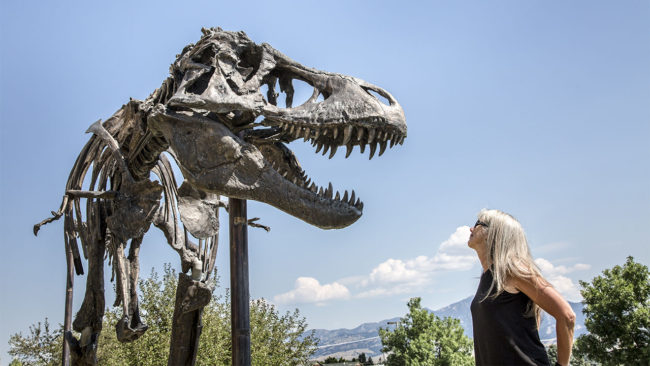
The claim is that Dinosaur DNA has indeed been found. The source is not some crank tabloid but rather is the publication of a study within a very reliable science journal.
It is also highly controversial. First, we shall take a quick look at the claim itself. Then we will briefly review what the two major problems are.
What makes this fascinating is that here we are standing at the cusp of what just might be a new window opening into the past. If this is indeed verified then it would be a complete game-changer for paleontology. This would be the beginning of molecular paleontology. However, what is also rather important is to ensure that we are not completely fooling ourselves. Serious doubts persist. These doubts do not rest in professional rivalry or anything like that, but rather in this – extraordinary claims really do need extraordinary evidence and so far two serious problems persist, hence so do the doubts.
This is perhaps a case study of what it takes within a scientific context to persuade people about something very bold and new and to establish that it really is true.
Study: Evidence of proteins, chromosomes and chemical markers of DNA in exceptionally preserved dinosaur cartilage
Published within the National Science Review on 12th January 2020, the abstract explains …
A histological ground-section from a duck-billed dinosaur nestling (Hypacrosaurus stebingeri) revealed microstructures morphologically consistent with nuclei and chromosomes in cells within calcified cartilage. We hypothesized that this exceptional cellular preservation extended to the molecular level and had molecular features in common with extant avian cartilage. Histochemical and immunological evidence supports in situpreservation of extracellular matrix components found in extant cartilage, including glycosaminoglycans and collagen type II. Furthermore, isolated Hypacrosaurus chondrocytes react positively with two DNA intercalating stains. Specific DNA staining is only observed inside the isolated cells, suggesting endogenous nuclear material survived fossilization. Our data support the hypothesis that calcified cartilage is preserved at the molecular level in this Mesozoic material, and suggest that remnants of once-living chondrocytes, including their DNA, may preserve for millions of years.
Translation: We have discovered Dinosaur DNA from 75 millions years ago.
Skepticism
There are two fundamental problems here. Let’s review each in turn.
Problem 1: Credibility of the Claim
Is it possible for bits of protein or DNA to survive 75 million years?
The oldest DNA sequenced came from a 700,000-year-old horse frozen in permafrost. However, samples of genetic information from the tooth enamel of a rhinoceros that lived 1.7 million years ago has also been extracted. That’s a long way from 75 million years.
The big problem here, when dealing with such large timescales, is that DNA’s half-life has been estimated at 521 years. This means that under ideal conditions, all the DNA bonds would be completely destroyed in bone after about 6.8 million years, hence anything older than that is simply not credible.
Problem 2: Reproducibility
Claims of Dinosaur DNA or proteins has been popping up since about 1993. All of the claims have come from one source – Mary Higby Schweitzer. She is one of the authors of this latest paper.
Nobody else has managed to reproduce her results, hence serious doubts persist. Science published an article that dug into the controversy back in 2017 – “‘I don’t care what they say about me’: Paleontologist stares down critics in her hunt for dinosaur proteins”…

CYNTHIA MATTY-HUBER
But no one except Schweitzer and her collaborators has been able to replicate their work. Although the study of ancient proteins, or paleoproteomics, is taking off, with provocative new results announced every few weeks, most findings come from samples thousands or hundreds of thousands of years old—orders of magnitude younger than Schweitzer’s dinosaurs.
“I want them to be right,” says Matthew Collins, a leading paleoproteomics researcher at the University of York in the United Kingdom. “It’s great work. I just can’t replicate it.“
Others are harsher, and suggest that Schweitzer’s protein pieces come from bacteria or contaminants. “It’s problematic that no other lab has been able to replicate Mary Schweitzer’s work,” says Jakob Vinther, a paleontologist at the University of Bristol in the United Kingdom, who’s tried to do so. “The idiom that exceptional claims require exceptional evidence remains,” adds Michael Buckley, a paleontologist at the University of Manchester, also in the United Kingdom.
… Maria McNamara, a paleontologist at University College Cork in Ireland. “If you are going to make claims for preservation, you really need to have tight arguments. At this point I don’t think we are quite there.”…
While this reproduction failure remains, doubts will not only persist, but the viability of it all is seriously hampered.
The complete lack of any replication means that being skeptical about all of this is your path to an acceptance of as many true things as possible.
To be clear, this is not a binary true-false issue, but is more akin to a sliding scale. I’m not dismissing the claim as entirely false, nor am I completely accepting it. While the credibility of the claim remains implausible and the lack of replication persists, then the confidence in it all should remain low, very low. Our desire for it to be true and the high credibility of those involved should not in any way change that stance.
Replication is king.
Further Reading
- Study in National Science Review (Jan 2020) – Evidence of proteins, chromosomes and chemical markers of DNA in exceptionally preserved dinosaur cartilage
- Wikipedia page for Mary Higby Schweitzer
- Live Science (Oct 2012) – ‘Jurassic Park’ May Be Impossible, But Dino DNA Lasts Longer Than Thought
- Smithsonian (Sep 2019) – 1.7-Million-Year-Old Rhino Tooth Provides Oldest DNA Data Ever Studied
